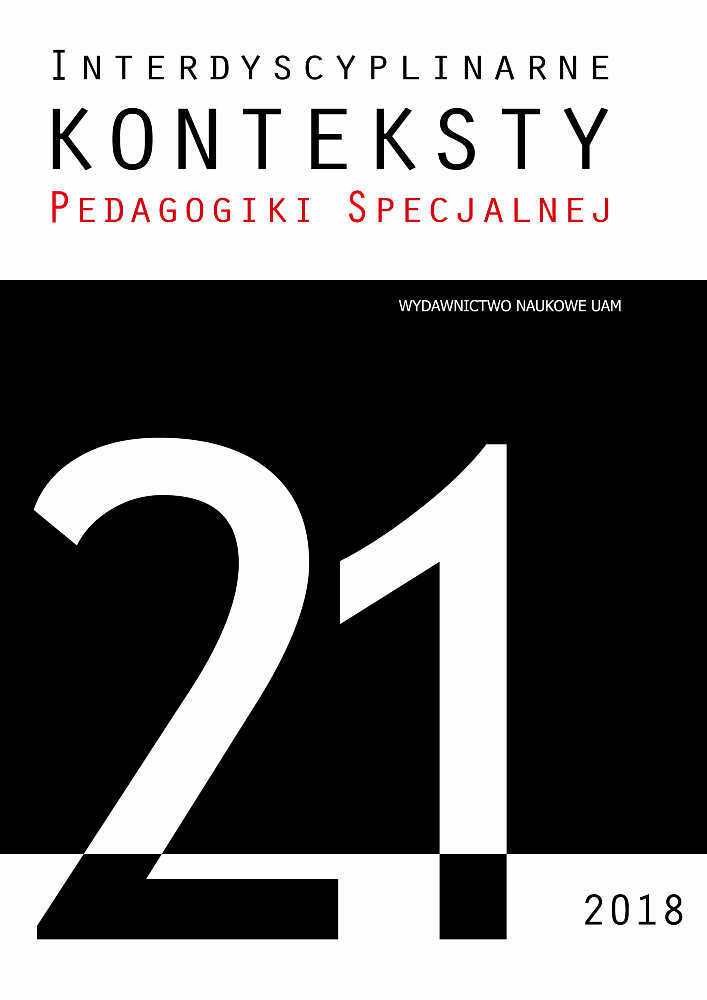Abstrakt
The article is devoted to the problems of disability seen through the prism of needs, both those referred to as special (special educational, developmental, professional needs), as well as those universal. The term (special) needs were analyzed, in particular the problem of losing its basic, psychological significance in the special pedagogy of recent years, as well as its theoretical and practical explorations in relation to nursing-compensating, educational and therapeutic activities. Text points attention to the need to update analyzes consistent with the idea of inclusion, in relation to the issue of the needs of people with disabilities, as a motivating factor and compensation area.
Bibliografia
Barnes C, Sheldon A. (2007), ‘Emancipatory’ disability research and special educational needs [In:] Florian L. ed. The Sage handbook of special education. London: Sage; pp.233–246.
Bigs A. (2008), Orem’s Self-Care Deficit Nursing Theory: Update on the State of the Art and Science, Nursing Science Quarterly, Vol. 21, Issue: 3; pp. 200-206.
Binnebesel J. (2010), Tanatopedagogika w doświadczeniu wielowymiarowości człowieka i śmierci, Wydawnictwo Adam Marszałek, Toruń.
Gernsbacher M.A., Raimond A.R., Balinghasay M.Th., Boston J.S. (2016), “Special needs” is an ineffective euphemism, Cognitive Researche No 1(1): 29; https://doi.org/10.1186/s41235-016-0025-4, [Pub. Online 2016 Dec 19], [access: 2018.01.15].
Harris J., Morgan H., Glendinning C. et al. (2006), Personalised social care for adults with disabilities: a problematic concept for frontline practice. Health & Social Care in the Community, 2006,14:125-135.
Kenrick D.T. , Griskevicius V., Neuberg S.L., Schaller M. (2010), Renovating the Pyramid of Needs: Contemporary Extensions Built Upon Ancient Foundations, Perspect Psychol Sci. 2010 May; 5(3): 292–314.
Kowalik G., Praktyczne zastosowanie modelu pielęgnowania Dorothy Orem, Studia Medyczne 2012, 26 (2), s. 107-111.
Luckasson, R., Coulter, D. L., Polloway, E. A., Reiss, S., Schalock, R. L., Snell, M. E., et al. (1992). Mental retardation: Definition, classification, and systems of supports (9th ed.). Washington, DC: AAMR.
Noltemeyer A., Bush K., Patton J., Bergen D. (2012), The relationship among deficiency needs and growth needs: An empirical investigation of Maslow’s theory, Children and Youth Services Review, Vol. 34, Issue 9, September 2012, pp. 1862-1867.
Obuchowski K. (2000): Galaktyka potrzeb – psychologia dążeń ludzkich, Wyd. Zysk i Ska, Poznań.
Orem, D. (2001). Nursing: Concepts of practice. St. Louis, MO: Mosby.
Pilecka W. (2002), Przewlekła choroba somatyczna w rozwoju dziecka, Kraków.
Płaszewska-Żywko I., Wilczek-Rużyczka E. (2000), Teoria pielęgnowania Dorothea’Orem, Studia Medyczne 26(2), S. 107-111.
Podgórska-Jachnik D. (2014), Praca socjalna z osobami z niepełnosprawnością I ich rodzinami, Centrum Rozwoju Zasobów Ludzkich MPiPS, Warszawa.
Pyżalski J., Podgórska-Jachnik D. (red.) (2016), Badanie potrzeb i satysfakcji z wybranych usług skierowanych do rodzin z dziećmi z orzeczoną niepełnosprawnością w wieku 8-16 lat. Raport z badań Instytutu Medycyny Pracy na zlecenie Regionalnego Centrum Polityki Społecznej w Łodzi, [online] http://www.imp.lodz.pl/upload/aktualnosci/2016/raport.pdf, [dostęp: 5.01.2018].
Rathus S.C. (2005), Psychologia współczesna, Wyd. GWP, Gdańsk.
Sochańska-Kawiecka M. i wsp.(2017), Badanie potrzeb osób niepełnosprawnych – RAPORT KOŃCOWY; Badania Społeczne MSK, PFRON, [online] https://www.pfron.org.pl/fileadmin/Badania_i_analizy/Badanie_potrzeb_ON/Raport_koncowy_badanie_potrzeb_ON.pdf [dostęp: 5.01.2018].
The Warnock Report (1978), Special Educational Needs. Report of the Committee of Enquiry into the Education of Handicapped Children and Young People. London: Her Majesty’s Stationery Office.
Netografia
http://portalwiedzy.onet.pl/tlumacz.html?qs=need&tr=ang-auto&x=35&y=8.
http://www.slownikonline.pl/kopalinski/6912E60D67C51EA4412565BA002919B3.php.

